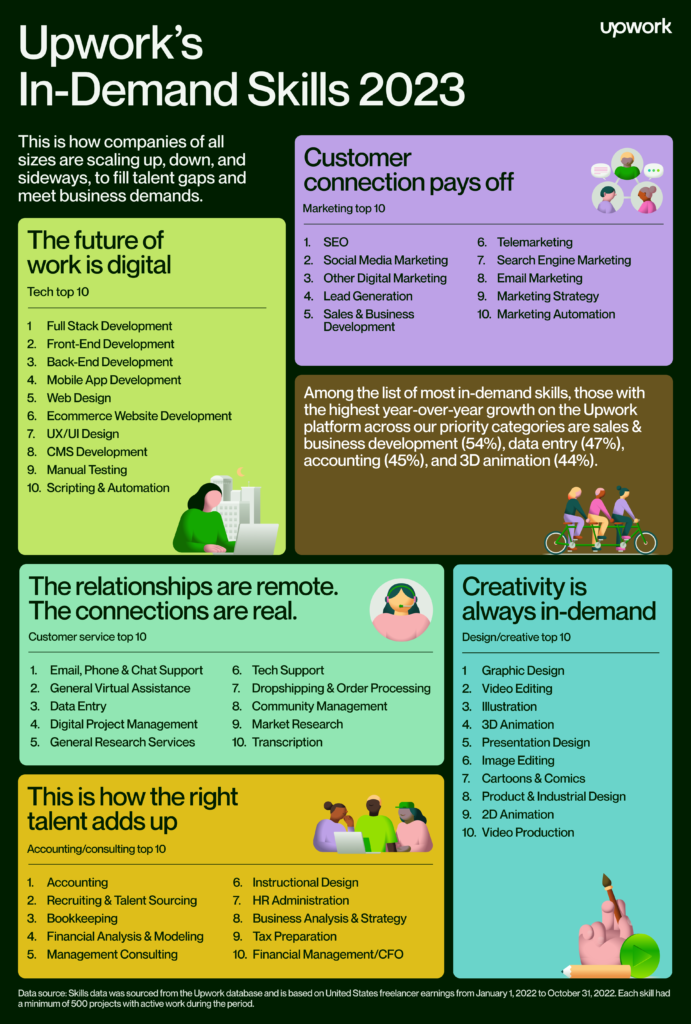Have you just graduated from UDSM and don’t know what to do next? Still at SAUT or any college and feel like the future of employment is uncertain? Don’t sit with your skills; get started with freelancing.
Online freelancing may be a mere story because it’s not a common way of working in Tanzania. But the story of Baraka Mafole, a successful freelance digital marketer, may be an example of this new way of employment.
Here are steps to get you started:
1. Choose one monetizable skill
There are many high-value skills that will get you paid in 2023 and beyond. According to Upwork’s In-Demand Skills 2023, the top skills businesses seek from skilled freelancers are found in Technology, Marketing, Customer Service, Accounting & Consulting, and Design & Creative skills. See the infographic below 👇🏼

To start your freelancer career, pick any of the skills you’re interested in, study about it online and start charging for it as a service.
2. Create a mock portfolio
A portfolio is simply a collection of your work, such as graphics, social media captions, website mockups, videos, etc. If you haven’t done any work, we call it a Mock Portfolio.
No one wants to hire a freelancer without knowing what to expect; a mock portfolio will speak volumes about the quality of your work, more so than a CV. Have a sample of your personal work that you did to showcase your abilities and qualities to prospective clients.
3. Create your offer
Consider the service you provide to your client and make an offer on how much you will charge for that particular service. Make sure your offer meets the quality of work a client expects from you.
4. Plan your pricing
To get a base for what to charge per project, look at the pricing of freelancers who offer similar services to yours. Don’t undercharge or overcharge; charge according to the value of the work you are putting in.
5. Set Work Terms
Determine how you are going to provide your service in terms of payment model, delivery time, reviews, and other important requirements. All of this should be written into a contract to establish a clear working environment and understand the boundaries of both parties.
6. Reach out to 10 people every day
Who are the people that you’re looking for to use your freelancing service? Where can you find them? Most are found on social media, where you can send them personalized emails, DMs, or a direct call and ask for a chance to pitch your offer.
An example of a reach-out message with your offer:
Hello Shukuru, I came across Tanzlite Digital on Instagram and noticed that you guys haven’t posted for months. I’m reaching out to see if you may need a hand on keeping your page updated with engaging educational, humorous, and even entertaining posts around your industry.
I am just starting my freelancing journey and here is my mock portfolio. I will post 4x a week, design simple graphics and short videos.
If the idea of keeping your page updated sounds great to you, I can do that for you for an entry fee of Tsh XXXXX per month. Let me know what you think.
7. Follow-Up and Book Calls
After reaching out, make sure to follow up and create a connection. Ask them for a response to know where they stand regarding your offer. Don’t get tired of checking them out.
8. Repeat the process
It won’t take more than 10 days of constant dedication to steps 6 and 7 before you find your potential client. Keep revising other steps whenever necessary to upgrade your profile after getting your first client.
In Conclusion
The job market in Tanzania has become intensely competitive. Everyone is a graduate these days. You have two choices; find a normal job in a company (if you’re lucky), or put yourself in the open market (the internet) where there are millions of people willing to pay for your services.
Above all, you need determination, consistency, and a commitment to continuous learning.
Thank you for reading. I am Geraldina Komba, I write about the digital economy, freelancing and personal branding.







0 Comments